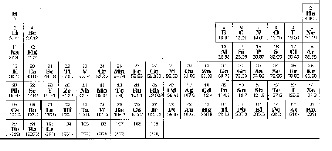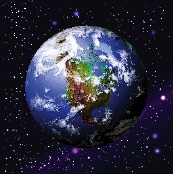

 One of the things that skeptics of the existence
of God and people
immersed in UFO claims seem to share is the belief that there may be
intelligent beings elsewhere in the cosmos who are made up of different
substances than we are and live differently than we do. It may very
well be that there is life elsewhere in the cosmos. The Bible does not
say that this is the only place where God has seen fit to create life,
and it would be foolish to dogmatically insist that life is peculiar to
planet Earth. The fact remains, however, that every observation that
mankind has made of other galaxies, other stars, all cosmic material,
and now even planets orbiting other stars has shown that they are made
of the same materials and function according to the same physical laws
that we see operative on Earth. Carl Sagan, a favorite authority used
by skeptics and UFOlogists alike, said it well. "The laws of chemistry
and physics are the same everywhere in the cosmos."
One of the things that skeptics of the existence
of God and people
immersed in UFO claims seem to share is the belief that there may be
intelligent beings elsewhere in the cosmos who are made up of different
substances than we are and live differently than we do. It may very
well be that there is life elsewhere in the cosmos. The Bible does not
say that this is the only place where God has seen fit to create life,
and it would be foolish to dogmatically insist that life is peculiar to
planet Earth. The fact remains, however, that every observation that
mankind has made of other galaxies, other stars, all cosmic material,
and now even planets orbiting other stars has shown that they are made
of the same materials and function according to the same physical laws
that we see operative on Earth. Carl Sagan, a favorite authority used
by skeptics and UFOlogists alike, said it well. "The laws of chemistry
and physics are the same everywhere in the cosmos."
Life on Earth is based on the chemistry of
carbon. There are over 90
naturally occurring elements in the cosmos, but carbon has a unique set
of properties which enables it to form everything from cells to
cyanide. In the chart below is a copy of what is called the periodic
chart. (A clearer copy of the periodic chart/table is at this link,
which is a PDF file of a periodic table from
http://science.widener.edu/~svanbram/ptable.html. You will need the
free Adobe Acrobat
Reader to view this file.) This is a logical
arrangement of all of the elements in the
cosmos based upon their composition and structure. In order to form
life and life-supporting materials, elements must hold on to their
electrons, but not hold on to them too strongly. Elements on the left
side of the periodic chart do not hold on to their electrons very well.
It is very easy to strip electrons away--a process called ionization.

In a similar way, the elements on the far right hand side of the chart require massive amounts of energy to take away an electron. Very frequently these materials like chlorine (number 17 in the chart) will take an electron away from a material in the left hand column (like sodium, number 11) and produce a material like salt (which is sodium chloride). The long chains of atoms necessary to form cells and the organic compounds that support life cannot be made of atoms that are easily ionized either by losing or gaining an electron.
Another trend in the chart is the size of the atoms. As you move to the right in the chart and as you move down in the chart, atoms become larger. We all know that you cannot build a house out of huge boulders or grains of sand--there is an optimum size to the particles that you use to do construction with. Another property of the chart is how metallic the materials are. Metals have a certain set of properties--they tend to conduct electricity, be shiny, and do a number of chemical things that nonmetals do not do. The left side of the chart and the bottom of the chart tend to be more metallic in nature. On the right hand side of the chart you have materials that do not have metallic properties. These materials, like the halogens in the next to last column, are usually gases and are very harsh chemically active materials. The very last column on the right are called the inert gases, which are totally inactive chemically.
 In the middle of all of this, we see a vertical row made
up of
carbon, silicon, germanium, tin, and lead. Tin and lead are very
metallic and could not be used to form life materials. That leaves us
with carbon, silicon, and germanium as materials that are perfect
chemically to form life and life-support materials. The electron
configuration of these materials have what is called an sp-3 hybrid
structure. What that means is that these atoms have their electrons
arranged in such a way that they can form a virtually unlimited number
of structures. They can arrange themselves end to end and make long
chains of materials sharing electrons between them. They can form a
stronger bond by sharing two electrons each and produce a whole new
series of compounds. They can arrange themselves into rings, and the
rings can even be hooked together. Every combination produces a new
family of materials which have a family name--the alkanes, the
alcohols, the
In the middle of all of this, we see a vertical row made
up of
carbon, silicon, germanium, tin, and lead. Tin and lead are very
metallic and could not be used to form life materials. That leaves us
with carbon, silicon, and germanium as materials that are perfect
chemically to form life and life-support materials. The electron
configuration of these materials have what is called an sp-3 hybrid
structure. What that means is that these atoms have their electrons
arranged in such a way that they can form a virtually unlimited number
of structures. They can arrange themselves end to end and make long
chains of materials sharing electrons between them. They can form a
stronger bond by sharing two electrons each and produce a whole new
series of compounds. They can arrange themselves into rings, and the
rings can even be hooked together. Every combination produces a new
family of materials which have a family name--the alkanes, the
alcohols, the  aldehydes, the
ketones, etc. These three elements can
behave as a metal or as a nonmetal depending upon what is around them.
They can conduct electricity, but do not do it too well. A small
impurity can radically change the way in which they conduct
electricity--which has led to semiconductors and the whole electronics
industry.
aldehydes, the
ketones, etc. These three elements can
behave as a metal or as a nonmetal depending upon what is around them.
They can conduct electricity, but do not do it too well. A small
impurity can radically change the way in which they conduct
electricity--which has led to semiconductors and the whole electronics
industry.
Of the three elements that make up this group of wonderful atoms, carbon is the most versatile. Carbon has six electrons which allows it to be relatively small and to have greater control of its electrons (a property known as electronegativity). The nucleus of carbon is less than half the weight of silicon and six times lighter than germanium. That means that even though the three atoms have similar electron configurations, carbon is much lighter, easier to move, and a more flexible choice for living materials than the other two.
 Virtually all of organic chemistry is the chemistry of
carbon.
Carbon can be arranged in a lattice that makes a diamond. It can be
made into granules which we call graphite. Carbon can be made into
little balls called buckyballs, which we are just beginning to find
ways to use. It can be combined with oxygen to make carbon dioxide, or
in limited amounts of oxygen it forms carbon monoxide. Adding more
oxygen and hydrogen produces sugar (glucose) and still more produces
fructose (another sugar). Combine glucose and fructose and you get
sucr
Virtually all of organic chemistry is the chemistry of
carbon.
Carbon can be arranged in a lattice that makes a diamond. It can be
made into granules which we call graphite. Carbon can be made into
little balls called buckyballs, which we are just beginning to find
ways to use. It can be combined with oxygen to make carbon dioxide, or
in limited amounts of oxygen it forms carbon monoxide. Adding more
oxygen and hydrogen produces sugar (glucose) and still more produces
fructose (another sugar). Combine glucose and fructose and you get
sucr ose or normal table sugar. Add some nitrogen to these
atoms and you
can get a protein.
ose or normal table sugar. Add some nitrogen to these
atoms and you
can get a protein.
It is interesting that carbon makes up a very small percentage of the earth's crust. Silicon makes up 28 percent of the crust and oxygen makes up 47 percent. The rest is aluminum (18 percent) and other metals (16 percent). These elements make up the rocks that support us, but life itself is made up of carbon which is relatively rare compared to these other elements. The source of carbon is believed to have been nuclear fusion in ancient stars. To have all of life produced by an element is relatively rare on the earth, not a primary product of the sun, and yet vital for all of life is a most interesting situation. As we look at other rocky planets and at our moon, we see extremely small amounts of carbon. Only in the huge gas planets like Jupiter and Saturn do we see significant amounts of carbon.
 So would we expect
to find aliens elsewhere made of chemistry
radically different than ours? The answer is "no." Carl Sagan used to
call himself a "carbon chauvinist" because, whatever life there is in
the cosmos, will have to be made of carbon, not silicon, germanium, or
some other element. If people want to talk about rock people or fire
people they can do so, but not in a scientific framework. That would be
more of a fantasy perspective. Is there life elsewhere made of carbon
compounds? Who knows; but if it is found, it will have been produced by
the same chemist and engineer that produced it here on Earth. All of
the evidence suggest that the chemist and the engineer was not mindless
chance. We truly can know there is a God through the things He has made
(Romans
1:19-22), and carbon is a wonderful designed foundation for that
life, where ever it may be found.
So would we expect
to find aliens elsewhere made of chemistry
radically different than ours? The answer is "no." Carl Sagan used to
call himself a "carbon chauvinist" because, whatever life there is in
the cosmos, will have to be made of carbon, not silicon, germanium, or
some other element. If people want to talk about rock people or fire
people they can do so, but not in a scientific framework. That would be
more of a fantasy perspective. Is there life elsewhere made of carbon
compounds? Who knows; but if it is found, it will have been produced by
the same chemist and engineer that produced it here on Earth. All of
the evidence suggest that the chemist and the engineer was not mindless
chance. We truly can know there is a God through the things He has made
(Romans
1:19-22), and carbon is a wonderful designed foundation for that
life, where ever it may be found.
Back to Contents Does God Exist?, SepOct07.